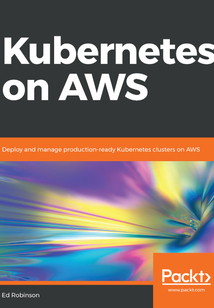舉報 

會員
Kubernetes on AWS
Dockercontainerspromisetoradicalizethewaydevelopersandoperationsbuild,deploy,andmanageapplicationsrunningonthecloud.Kubernetesprovidestheorchestrationtoolsyouneedtorealizethatpromiseinproduction.KubernetesonAWSguidesyouindeployingaproduction-readyKubernetesclusterontheAWSplatform.YouwillthendiscoverhowtoutilizethepowerofKubernetes,whichisoneofthefastestgrowingplatformsforproduction-basedcontainerorchestration,tomanageandupdateyourapplications.Kubernetesisbecomingthego-tochoiceforproduction-gradedeploymentsofcloud-nativeapplications.ThisbookcoversKubernetesfromfirstprinciples.YouwillstartbylearningaboutKubernetes'powerfulabstractions-PodsandServices-thatmakemanagingcontainerdeploymentseasy.Thiswillbefollowedbyaguidedtourthroughsettingupaproduction-readyKubernetesclusteronAWS,whilelearningthetechniquesyouneedtosuccessfullydeployandmanageyourownapplications.Bytheendofthebook,youwillhavegainedplentyofhands-onexperiencewithKubernetesonAmazonWebServices.Youwillalsohavepickedupsometipsondeployingandmanagingapplications,keepingyourclusterandapplicationssecure,andensuringthatyourwholesystemisreliableandresilienttofailure.
目錄(204章)
倒序
- coverpage
- Title Page
- About Packt
- Why subscribe?
- Packt.com
- Contributors
- About the author
- About the reviewer
- Packt is searching for authors like you
- Preface
- Who this book is for
- What this book covers
- To get the most out of this book
- Download the example code files
- Conventions used
- Get in touch
- Reviews
- Google's Infrastructure for the Rest of Us
- Why do I need a Kubernetes cluster?
- The roots of containers
- Enter the container
- Cgroups
- Namespaces
- Putting the pieces together
- Here schedule this...
- The basics of Kubernetes
- The pod
- Labeling all the things
- Replica sets
- Services
- Under the hood
- API server
- Controller manager
- Scheduler
- Kubelet
- Summary
- Start Your Engines
- Your own Kubernetes
- Installation
- macOS
- Linux
- Windows
- Starting Minikube
- First steps with kubectl
- Building Docker containers inside the cluster
- Building and launching a simple application on Minikube
- What just happened?
- Rolling out changes
- Resilience and scaling
- Using the dashboard
- Configuration as code
- Troubleshooting Minikube
- Summary
- Reach for the Cloud
- Cluster architecture
- Creating an AWS account
- Creating an IAM user
- Getting the CLI
- Setting up a key pair
- Preparing the network
- Setting up a bastion
- sshuttle
- Instance profiles
- Kubernetes software
- Docker
- Installing Kubeadm
- Building an AMI
- Bootstrapping the cluster
- What just happened?
- Access the API from your workstation
- Setting up pod networking
- Launching worker nodes
- Demo time
- Summary
- Managing Change in Your Applications
- Running pods directly
- Jobs
- CronJob
- Cron syntax
- Concurrency policy
- History limits
- Managing long running processes with deployments
- kubectl patch
- kubectl edit
- kubectl apply
- Kubernetes dashboard
- Greater control of your deployments
- RollingUpdate deployment
- Recreate deployment
- DaemonSet
- Summary
- Managing Complex Applications with Helm
- Installing Helm
- macOS
- Linux and Windows
- Installing Tiller
- Installing a chart
- Configuring a chart
- Creating your own charts
- Chart.yaml
- values.yaml
- templates
- Making it your own
- Developing and debugging
- Templating language
- Functions
- Flow control
- Hooks
- Packaging Helm charts
- You can test building an index
- Using your repository
- Organizational patterns for Helm
- Chart per application
- Shared charts
- Library charts
- Next steps
- Planning for Production
- The design process
- Initial planning
- Planning for success
- Planning for a successful roll out
- Discovering requirements
- Availability
- Capacity
- EC2 instance types
- EC2 instance types
- Breadth versus depth
- Performance
- Disk performance
- gp2
- io2
- st1
- sc1
- Networking
- Security
- Always be updating
- In-place updates
- Immutable images
- Network security
- Infra-node networking
- Node-master networking
- External networking
- Kubernetes infra-pod networking
- IAM roles
- Validation
- Observability
- Logging
- Monitoring
- Blackbox monitoring
- Alerting
- Tracing
- Summary
- A Production-Ready Cluster
- Building a cluster
- Getting started with Terraform
- Variables
- Networking
- Plan and apply
- Control Plane
- Preparing node images
- Installing Packer
- Packer configuration
- Node group
- Provisioning add-ons
- Managing change
- Summary
- Sorry My App Ate the Cluster
- Resource requests and limits
- Resource units
- How pods with resource limits are managed
- Quality of Service (QoS)
- Resource quotas
- Default limits
- Horizontal Pod Autoscaling
- Deploying the metrics server
- Verifying the metrics server and troubleshooting
- Autoscaling pods based on CPU usage
- Autoscaling pods based on other metrics
- Autoscaling the cluster
- Deploying the cluster autoscaler
- Summary
- Storing State
- Volumes
- EBS volumes
- Persistent volumes
- Persistent volumes example
- Storage classes
- StatefulSet
- Summary
- Further reading
- Managing Container Images
- Pushing Docker images to ECR
- Creating a repository
- Pushing and pulling images from your workstation
- Setting up privileges for pushing images
- Use images stored on ECR in Kubernetes
- Tagging images
- Version Control System (VCS) references
- Semantic versions
- Upstream version numbers
- Labelling images
- Summary
- Other Books You May Enjoy
- Leave a review - let other readers know what you think 更新時間:2021-06-10 18:41:56
推薦閱讀
- 輕松學(xué)C語言
- 基于LPC3250的嵌入式Linux系統(tǒng)開發(fā)
- 21天學(xué)通Java
- 統(tǒng)計策略搜索強化學(xué)習(xí)方法及應(yīng)用
- 現(xiàn)代傳感技術(shù)
- 水晶石精粹:3ds max & ZBrush三維數(shù)字靜幀藝術(shù)
- 可編程序控制器應(yīng)用實訓(xùn)(三菱機型)
- 數(shù)據(jù)庫系統(tǒng)原理及應(yīng)用教程(第5版)
- 液壓機智能故障診斷方法集成技術(shù)
- MongoDB 4 Quick Start Guide
- Photoshop CS4數(shù)碼照片處理入門、進階與提高
- 簡明學(xué)中文版Flash動畫制作
- 樂高創(chuàng)意機器人教程(中級 上冊 10~16歲) (青少年iCAN+創(chuàng)新創(chuàng)意實踐指導(dǎo)叢書)
- Instant Slic3r
- 渲染王3ds Max三維特效動畫技術(shù)
- 軟測之魂
- 軟件質(zhì)量管理實踐
- 商務(wù)智能
- Artificial Intelligence for Robotics
- 隨機分布控制系統(tǒng)的故障診斷與容錯控制
- Talend for Big Data
- Learning AWK Programming
- MATLAB機器學(xué)習(xí)
- Mastering Citrix? XenServer?
- jQuery即學(xué)即用
- Python數(shù)據(jù)挖掘入門與實踐
- Teradata Cookbook
- CCNA認證指南(640-802)
- Photoshop CS3中文版圖像處理與創(chuàng)意設(shè)計
- 讓Excel飛!

